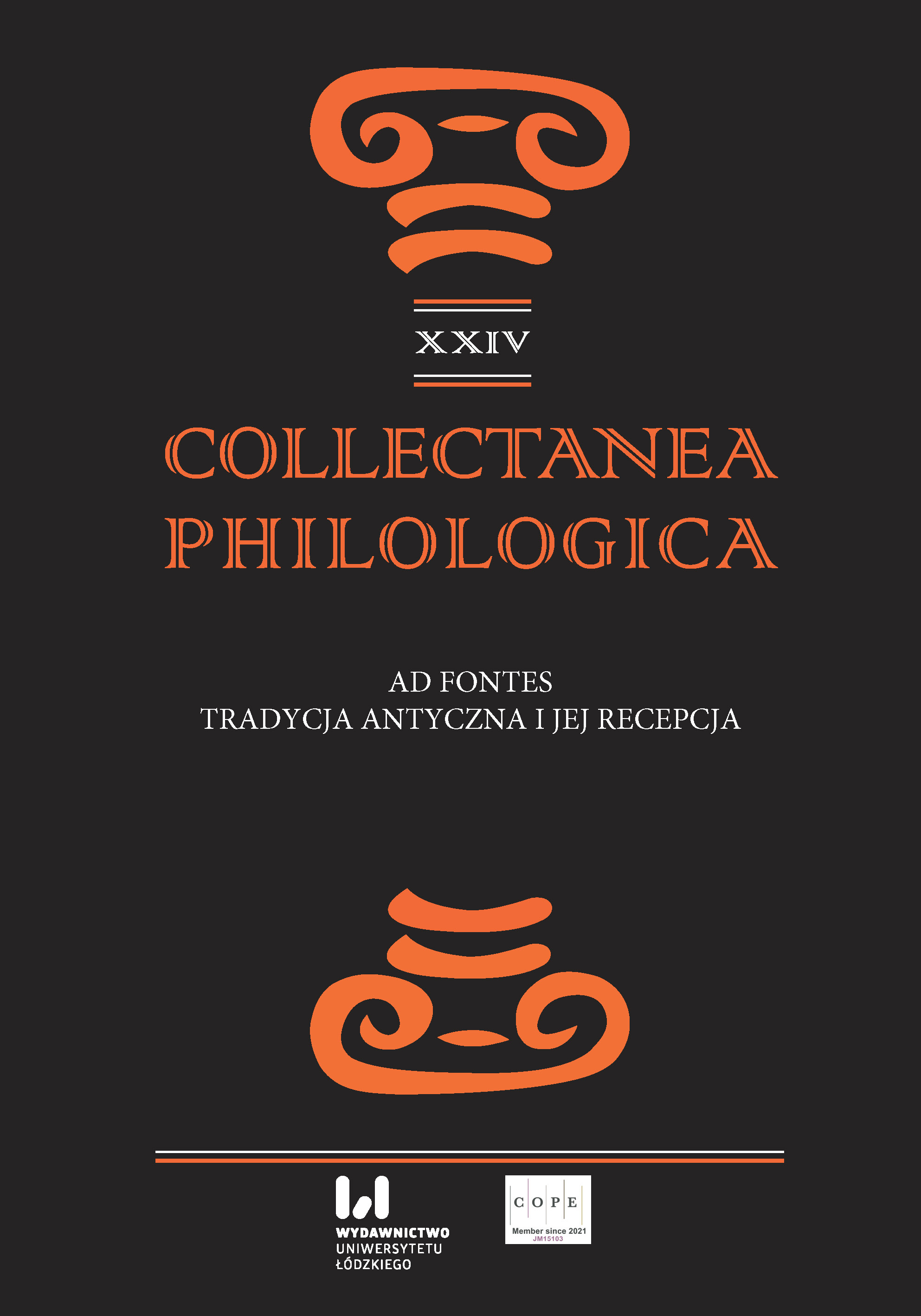Renesansowy poemat "Sarca" jako "aemulatio" z autorami antycznymi
DOI:
https://doi.org/10.18778/1733-0319.24.09Słowa kluczowe:
Pietro Bembo, Katullus, renesans, aemulatio, epithalamium, neolatynistykaAbstrakt
The aim of this article is to analyse the Renaissance poem Sarca, whose authorship is attributed to the Italian humanist Pietro Bembo, and to indicate the ancient inspirations of the work. The main model for the work is Carmen 64 by Catullus, although the author also refers to other Roman poets. The intertextual relations between Sarca and the hypotexts are presented on various levels. The analysis focuses on showing parallel elements of the setting and takes in consideration the few similarities at the linguistic and stylistic level. Genre-wise Sarca is classified as an epithalamium of an aythiological character. Its characteristics typical of the Renaissance era are also highlighted. The article also brings up the history of the poem and the topic of its attribution, presenting an extensive state of research.
Bibliografia
Bembo, P. (2005). Lyric Poetry. Etna. Trans. M.P. Chatfield. Cambridge–Massechusetts–London: Harvard University Press.
Google Scholar
Burckhardt, J. (1991). Kultura Odrodzenia we Włoszech. Próba ujęcia. Przeł. M. Kreczkowska. Warszawa: Czytelnik.
Google Scholar
Chatfield, M.P. (2005). Introduction. W: Bembo P., Lyric Poetry. Etna (s. VII–XX). Cambridge–Massechusetts–London: Harvard University Press.
Google Scholar
Elwert, W.T. (1969). „Il Lago di Garda nella poesia italiana del Cinquecento”. Il Lago di Garda, Atti del Congresso internazionale promosso dall’Ateneo di Salò II. 203–245. Salò: Atteneo di Salò.
Google Scholar
Fulińska, A. (1997). „Renesansowa aemulatio: alegacja czy intertekstualność?”. Teksty Drugie 4. 5–15.
Google Scholar
Fulińska, A. (2000). Naśladowanie i twórczość: renesansowe teorie imitacji, emulacji i przekładu. Wrocław: FNP.
Google Scholar
Gage, J. (2008). Kolor i kultura. Teoria i znaczenie koloru od antyku do abstrakcji. Przeł. J. Holzman. Kraków: Universitas.
Google Scholar
Głowiński, M. (1986). „O intertekstualności”. Pamiętnik Literacki 4. 90–91.
Google Scholar
Grimal, P. (1997). Słownik mitologii greckiej i rzymskiej. Wrocław: Ossolineum.
Google Scholar
Hymny homeryckie. (2001). Przeł. W. Appel. Toruń: Algo.
Google Scholar
Katullus. (2005). Poezje. Przeł. A. Świderkówna. Wrocław: Ossolineum deAgostini.
Google Scholar
Katullus. (2013). Poezje wszystkie. Przeł. G. Franczak, A. Klęczar, Kraków: Homini.
Google Scholar
Klęczar, A. (2013). Wstęp. W: Katullus, Poezje wszystkie. Przeł. G. Franczak, A. Klęczar. Kraków: Homini. 7–118.
Google Scholar
Korenjak, M. (2012). Short Mythological Epic in Neo-Latin Literature. W: Baumbach, M., Bär, S. (red.), Brill’s Companion to Greek and Latin Epyllion and its reception. Leiden–Boston: Brill.
Google Scholar
Kuciak, A. (2006). Przypisy. W: Alighieri, D. Boska komedia. Przeł. A. Kuciak. Poznań: Wydawnictwo AA.
Google Scholar
Mai, A. (1942). Spicilegium Romanum (vol. VIII). Roma: Typis Collegii Urbani.
Google Scholar
Morsolin, B. (1886–1887). „Il Sarca, poemetto latino di Pietro Bembo”. Atti del Reale Istituto Veneto di scienze lettere ed arti, dal novembre 1886 all’ottobre 1887 (vol. V, serie VI). Venezia: Tipografia G. Antonelli. 229–265.
Google Scholar
Olszaniec, W., Rzepkowski, K. (2013). Przypisy. W: Boccaccio, G., O słynnych kobietach. Przeł. P. Bańkowski. Warszawa: Wydawnictwo Uniwersytetu Warszawskiego.
Google Scholar
Ovidius. (1977). Metamorphoses. W.S. Anderson (ed.), Leipsig: B. G. Teubner.
Google Scholar
Pecoraro, M. (1959). Per la storia dei carmina del Bembo. Una redazione non vulgata. Roma: Istituto per la collaborazione culturale.
Google Scholar
Pighi, G.B. (1974). Sarca. Poema del XVI secolo. Testo latino e traduzione italiana con un saggio critico. Arco: Cartiera di Arco-Stamperia Valdonega.
Google Scholar
Piovesan, E. (1974). “L’autore del poemetto Sarca”. Atti e memorie della Accademia di Agricoltura, Scienze e Lettere di Verona, anno accademico 1973–1974 (vol. XXV, serie 6). 203–245.
Google Scholar
Schönberger, O. (1994). Sarca: Petrus Bembus: Einleitung, völlständiger Text, erste Übersetzung und Anmerkungen. Würzburg: Königshausen & Neumann.
Google Scholar
Zeno, A. (1782). Lettere (vol. III). Venezia: Apresso Francesco Sansoni.
Google Scholar
Opublikowane
Jak cytować
Numer
Dział
Licencja

Utwór dostępny jest na licencji Creative Commons Uznanie autorstwa – Użycie niekomercyjne – Bez utworów zależnych 4.0 Międzynarodowe.










